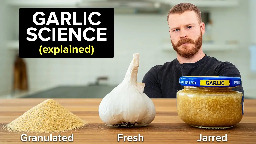This 45 min video promised a PhD in garlic 🧄



My takeaways after watching the whole thing:
As soon as garlic's cells are destroyed (cut, smashed, pressed) the process that creates allicin, the main compound responsible for fresh garlic's flavor and aroma, starts and peaks after 1 min. So, use garlic as freshly as possible.
Dried, or otherwise preserved garlic loses the allicin as it is very volatile. You still get a garlic like flavor from them, but it's always inferior to fresh. However, if you're cooking something where garlic is not the main flavor that is likely ok (only noticable in direct comparison).
I also made the cilantro chicken he used for a taste test yesterday and it was da bomb! Here's the recipe:
Marinade chicken thighs with a paste of:
- 4" ginger
- 1.5 lemon's juice
- garlic
- salt
Brown over medium high heat in neutral oil.
Top with Sauce, blended:
- 2 roma tomatoes
- green chillies
- squirt of tomato paste
- half bunch cilantro
- salt
After a few min finish with whole milk yogurt. Serve with rice, garnish with fresh cilantro.
In summary, the video is a bit slow at times (could probably have been a 20min video), but the information contained was interesting and helpful for anyone cooking with garlic :)
Pics for the recipe:
If anyone is interested: within the cells of the garlic clove, the two precursor molecules of allicin (alliin and an enzyme called alliinase) are kept separate. Alliin is stored within the cytosol of the cell, whereas the alliinase enzyme is sequestered in bubbles called vacuoles. When the cell wall and vacuole is disrupted through crushing or chopping (or attack by insects, fungi etc) the two molecules meet and react, eventually forming the short lived molecule allicin, which as has been pointed out, contributes significantly to garlic's characteristic aroma and flavour.
Incidentally, the compartmentalisation of the allicin precursors protects the garlic plant from self harm. As the allicin molecule is highly reactive, collateral damage to the plant's own cells is localised only to sites of tissue damage from microbes and other attackers.
Thanks! That is all covered in the video, I just left it out of my summary :)
@marco Never knew i needed this but indeed I did
I quite enjoy the place where science and cooking meet, as long as it it something that will actually make my food taste better :)
I’m sure you’ve watched more of Ethan’s stuff but he has some really good recipes and likes to combine the science and cooking!
I actually haven't watched his other videos but certainly will watch more :)
@marco Fair point :)
The big Chlebowski with the good stuff.
I really like Ethans work when he explains why stuff works and not just how.
Yeah, Ethan's one of my favourite science video essayists of the last couple years. The food porn is just a bonus.
Followed by Ethan devouring food like he's going to choke on it.
Such a good channel, the very methodical approach scratches some kind of itch.
I'm interested in where he got this recipe for cilantro chicken since it kinda looks and sounds like a chicken adobo recipe
Ethan did not mention where he got the recipe from in the video, only that he meant to try it for a while 🤷
The cilantro chicken tastes like an Indian dish to me. I see very few similarities between those recipes, besides chicken and garlic (no vinegar or soy sauce) .... I just watched Uncle Roger make Adobo the other day :)